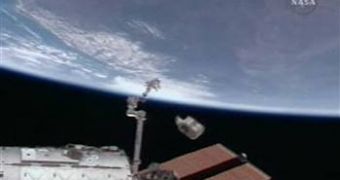More than one year ago, on July 23rd, 2007, NASA astronaut Clayton Anderson, a flight engineer on Expedition 15, tossed away into space a large piece of junk. During a spacewalk mission, with the help of the station's robotic arm built in Canada, he disposed of a useless tank, previously filled with ammonia coolant, as well as of a camera that was no longer needed. Ever since then, NASA has been tracking the object (who has thus become one of the 9,000 pieces of monitored, floating space debris), in order to avoid any threat that it might pose when entering atmosphere.
“I'll be sending my bill in the mail for trash disposal,” joked Anderson when he disposed of the 1,400-pound (635-kilogram) object. NASA specialists believe that the tank will break apart in the atmosphere, but about 15 pieces will actually hit the ground at speeds of 100 mph (160 km/h), or at least what's going to be left of them, after being affected by the heat generated by air friction. Some of these may still range in weight from 1.4 ounces (40 grams) to about 40 pounds (17.5 kilograms).
However, experts claim that there's little reason to worry. According to Mike Suffredini, the program manager of NASA's space station, “This has got a very low likelihood that anybody will be impacted by it. But still, it is a large object and pieces will enter and we just need to be cautious.” There's a high possibility that it will fall into the ocean, since 2 thirds of the planet are covered by water. Nevertheless, “If anybody found a piece of anything on the ground Monday morning, I would hope they wouldn't get too close to it,” warned Suffredini.
This Early Ammonia Servicer tank, which used to provide a boost to the cooling system of the International Space Station, is the largest junk piece that has been thrown away in space so far, after last year's upgrading mission to the station rendered it useless. We will update this article with more news on where it hits the Earth, as soon as they are available.

 14 DAY TRIAL //
14 DAY TRIAL //